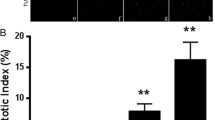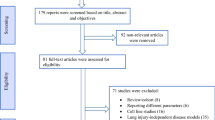Abstract
The present study focused on the therapeutic effects of resveratrol in a rat model of blunt chest trauma-induced acute lung injury and the potential role of endocan as a biomarker of inflammation. They were randomly divided into the following four groups (n = 7 in each group): control group (no treatment or trauma); trauma group (trauma-induced group); resveratrol group (resveratrol [0.3 mg/kg] administered via the i.p. route group); and resveratrol + trauma group (resveratrol [0.3 mg/kg] administered via the i.p. route 1 h prior to the induction of trauma At the end of the 24 h, all the experimental rats were sacrificed. Lung lobe and blood samples were collected for biochemical, histopathological, and immunohistochemical investigations. Serum endocan levels were found to be significantly higher in the travma, resveratrol, and resveratrol + trauma groups than in the control group (p < 0.001, p < 0.001, p < 0.001). Moreover, in resveratrol + trauma group, endocan showed a significant increase compared to trauma and resveratrol group (p < 0.001, p < 0.001). Serum MDA level was significantly higher in the trauma group than in the control group (p = 0.017). SOD showed a significant increase in resveratrol and resveratrol + trauma groups compared to control group (p < 0.001, p < 0.001). The present study suggested that resveratrol exerted antioxidant properties in a rat model of lung injury after blunt chest trauma. Thus, it may have therapeutic potential in cases of blunt chest trauma-induced lung injury. Serum levels of endocan were not correlated with the inflammation response. The clinical use of endocan as a biomarker of inflammation in lung injury caused by blunt chest trauma is not recommended.



Similar content being viewed by others
References
Couret, D., S. de Bourmont, N. Prat, P.Y. Cordier, J.B. Soureau, D. Lambert, B. Prunet, and P. Michelet. 2013. A pig model for blunt chest trauma: no pulmonary edema in the early phase. The American Journal of Emergency Medicine 31 (1): 220–225.
Seitz, D.H., U. Niesler, A. Palmer, M. Sulger, S.T. Braumüller, M. Perl, F. Gebhard, and M.W. Knöferl. 2010. Blunt chest trauma induces mediator-dependent monocyte migration to the lung. Critical Care Medicine 38: 1852–1859.
Perl, M., C. Hohmann, S. Denk, P. Kellermann, D. Lu, S. Braumüller, M.G. Bachem, J. Thomas, M.W. Knöferl, A. Ayala, F. Gebhard, and M.S. Huber-Lang. 2012. Role of activated neutrophils in chest trauma-induced septic acute lung injury. Shock 38: 98–106.
Hoth, J.J., R.S. Martin, B.K. Yoza, J.D. Wells, J.W. Meredith, and C.E. McCall. 2009. Pulmonary contusion primes systemic innate immunity responses. The Journal of Trauma 67: 14–21 discussion 21-2.
Yang, T., J. Zhang, L. Sun, X. Zhu, J. Li, J. Wang, H. Chen, R. Bao, X. Deng, J. Hou, and Y. Liu. 2012. Combined effects of a neutrophil elastase inhibitor (sivelestat sodium) and a free radical scavenger (edaravone) on lipopolysaccharide-induced acute lung injury in rats. Inflammation Research 61: 563–569.
Van der Wal, S.E., M. Vaneker, M. Kox, G. Braak, H.W. Van Hees, I.A. Van den Brink, F.M. Van de Pol, L.M. Heunks, J.G. Van der Hoeven, L.A. Joosten, K.C. Vissers, and G.J. Scheffer. 2014. Resveratrol attenuates NF-κB-binding activity but not cytokine production in mechanically ventilated mice. Acta Anaesthesiologica Scandinavica 58: 487–494.
Rieder, S.A., P. Nagarkatti, and M. Nagarkatti. 2012. Multiple anti-inflammatory pathways triggered by resveratrol lead to amelioration of staphylococcal enterotoxin B-induced lung injury. British Journal of Pharmacology 167: 1244–1258.
Özdemir, Ö.M., E. Gözkeser, F. Bir, and Ç. Yenisey. 2014. The effects of resveratrol on hyperoxia-induced lung injury in neonatal rats. Pediatrics and Neonatology 55: 352–357.
Liu, J., L. Yi, Z. Xiang, J. Zhong, H. Zhang, and T. Sun. 2015. Resveratrol attenuates spinal cord injury-induced inflammatory damage in rat lungs. International Journal of Clinical and Experimental Pathology 8: 1237–1246.
Lassalle, P., S. Molet, A. Janin, J.V. Heyden, J. Tavernier, W. Fiers, R. Devos, and A.B. Tonnel. 1996. ESM-1 is a novel human endothelial cell-specific molecule expressed in lung and regulated by cytokines. The Journal of Biological Chemistry 271: 20458–20464.
Béchard, D., T. Gentina, M. Delehedde, A. Scherpereel, M. Lyon, M. Aumercier, R. Vazeux, C. Richet, P. Degand, B. Jude, A. Janin, D.G. Fernig, A.B. Tonnel, and P. Lassalle. 2001. Endocan is a novel chondroitin sulfate/dermatan sulfate proteoglycan that promotes hepatocyte growth factor/scatter factor mitogenic activity. The Journal of Biological Chemistry 276: 48341–48349.
Yang, J., Q. Yang, S. Yu, and X. Zhang. 2015. Endocan: A new marker for cancer and a target for cancer therapy. Biomedical Reports 3: 279–283.
Zhang, H.X., G.L. Duan, C.N. Wang, Y.Q. Zhang, X.Y. Zhu, and Y.J. Liu. 2014. Protective effect of resveratrol against endotoxemia-induced lung injury involves the reduction of oxidative/nitrative stress. Pulmonary Pharmacology & Therapeutics 27: 150–155.
Raghavendran, K., B.A. Davidson, J.D. Helinski, C.J. Marschke, P. Manderscheid, J.A. Woytash, R.H. Notter, and P.R. Knight. 2005. A rat model for isolated bilateral lung contusion from blunt chest trauma. Anesthesia and Analgesia 101: 1482–1489.
Akdemir, H.U., A. Güzel, C. Katı, L. Duran, H. Alaçam, A. Gacar, T. Güvenç, N. Murat, and B. Sişman. 2014. The evaluation of different treatment protocols for trauma-induced lung injury in rats. Journal Thoracic Disease 6: 66–73.
Adams, E.J., J.A. Gren, A.H. Clark, and J.H. Youngson. 1999. Comparison of Different Scoring Systems for Immunohistochemical Staining. Journal of Clinical Pathology 52: 75–77.
True, L.D. 1990. Principles of immunohistochemistry. In Atlas of diagnostic immunohistopathology, ed. L.D. True, 16–22. New York: Gower Medical Publishing.
Hoth, J.J., J.D. Wells, E.M. Hiltbold, C.E. McCall, and B.K. Yoza. 2011. Mechanism of neutrophil recruitment to the lung after pulmonary contusion. Shock 35: 604–609.
Hoth, J.J., J.D. Stitzel, F.S. Gayzik, N.A. Brownlee, P.R. Miller, B.K. Yoza, C.E. McCall, J.W. Meredith, and R.M. Payne. 2006. The pathogenesis of pulmonary contusion: an open chest model in the rat. The Journal of Trauma 61: 32–44 discussion 44-5.
Wu, X., X. Song, N. Li, L. Zhan, Q. Meng, and Z. Xia. 2013. Protective effects of dexmedetomidine on blunt chest trauma-induced pulmonary contusion in rats. Journal of Trauma and Acute Care Surgery 74: 524–530.
Suresh, M.V., B. Yu, S. Lakshminrusimha, D. Machado-Aranda, N. Talarico, L. Zeng, B.A. Davidson, S. Pennathur, and K. Raghavendran. 2013. The protective role of MnTBAP in oxidant-mediated injury and inflammation in a rat model of lung contusion. Surgery 154: 980–990.
Seitz, D.H., M. Perl, S. Mangold, A. Neddermann, S.T. Braumüller, S. Zhou, M.G. Bachem, M.S. Huber-Lang, and M.W. Knöferl. 2008. Pulmonary contusion induces alveolar type 2 epithelial cell apoptosis: role of alveolar macrophages and neutrophils. Shock 30: 537–544.
Kozan, A., N. Kilic, H. Alacam, A. Guzel, T. Guvenc, and M. Acikgoz. 2016. The Effects of Dexamethasone and L-NAME on Acute Lung Injury in Rats with Lung Contusion. Inflammation 39: 1747–1756.
Smith, L.M., J.D. Wells, V.T. Vachharajani, B.K. Yoza, C.E. McCall, and J.J. Hoth. 2015. SIRT1 mediates a primed response to immune challenge after traumatic lung injury. Journal of Trauma and Acute Care Surgery 78: 1034–1038.
Liu, N., L.H. Zhang, H. Du, Y. Hu, G.G. Zhang, X.H. Wang, J.Y. Li, and J.F. Ji. 2010. Overexpression of endothelial cell specific molecule-1 (ESM-1) in gastric cancer. Annals of Surgical Oncology 17: 2628–2639.
Zuo, L., S.M. Zhang, R.L. Hu, H.Q. Zhu, Q. Zhou, S.Y. Gui, Q. Wu, and Y. Wang. 2008. Correlation between expression and differentiation of endocan in colorectal cancer. World Journal of Gastroenterology 14: 4562–4568.
Qiu CR, Fu Q, Sui J, Zhang Q, Wei P, Wu Y, Zhu K, Lu Y, Zong B. 2016. Serum endothelial cell-specific molecule 1 (Endocan) level in patients with acute myocardial infarction and its clinical significance: A pilot study. Angiology 68: 354–359.
Tang, L., Y. Zhao, D. Wang, W. Deng, C. Li, Q. Li, S. Huang, and C. Shu. 2014. Endocan levels in peripheral blood predict outcomes of acute respiratory distress syndrome. Mediators of Inflammation 2014: 625180.
Sumei, Z., C. Shaolong, W. Xiang, Q. Yinliang, Z. Qing, and W. Yuan. 2016. Endocan reduces the malign grade of gastric cancer cells by regulating associated protein expression. Tumour Biology 37: 14915–14921.
Mikkelsen, M.E., C.V. Shah, A. Scherpereel, P.N. Lanken, P. Lassalle, S.L. Bellamy, A.R. Localio, S.M. Albelda, N.J. Meyer, and J.D. Christie. 2012. Lower serum endocan levels are associated with the development of acute lung injury after major trauma. Journal of Critical Care 27: 522.e11–522.e17.
Author information
Authors and Affiliations
Corresponding author
Ethics declarations
The experimental protocol and all animal procedures were approved by the Experimental Ethics Committee of Ondokuz Mayis University, Samsun, Turkey.
Rights and permissions
About this article
Cite this article
Torun, A.C., Tutuncu, S., Ustun, B. et al. A Study of the Therapeutic Effects of Resveratrol on Blunt Chest Trauma-Induced Acute Lung Injury in Rats and the Potential Role of Endocan as a Biomarker of Inflammation. Inflammation 40, 1803–1810 (2017). https://doi.org/10.1007/s10753-017-0624-3
Published:
Issue Date:
DOI: https://doi.org/10.1007/s10753-017-0624-3




